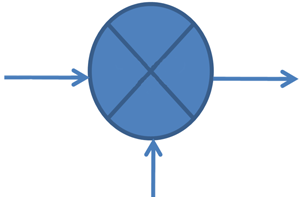Formulae for determining heterodyne system spurious frequencies that coincide with desired output frequency
DOI:
https://doi.org/10.3103/S0735272717110024Keywords:
down-conversion, fundamental mixing, harmonic mixing, nonlinear, order of mixing, spurious, up-conversionAbstract
In this paper, formulae to determine the lowest order and other higher order spurious frequencies that coincide with desired output signal frequencies of mixers have been derived. The proposed formulae give general expressions that are suitable for any order of heterodyne mixing. The formulae have been verified using a suitable example and compared with the simulation results obtained through the radio frequency simulation software of Advanced Design System. The formulae directly reveal the order of the troublesome spurious frequencies that the designers would encounter in heterodyne systems. In comparison with these direct formulae, the results of existing spurious analysis software are based on the maximum order of simulation carried out. Based on these simulations, the coinciding spurious components have to be manually sorted out. Proposed formulae are quick tools used by the microwave system and circuit designers for choosing and finalizing heterodyne frequencies in their designs without the need for any simulations.References
- MAAS, S.A. Nonlinear Microwave and RF Circuits. Norwood, MA: Artech House, 2003.
- EDWARDS, M. End-To-End System Design: Advantages of an Integrated Tool For Frequency Planning, Budget Analysis and More. Visual System Simulator, White Paper, 2010. URI: http://www.awrcorp.com/sites/default/files/content/attachments/VSS-System-Planning-White-Paper.pdf.
- KIRSHMAN, J. Understanding and Correctly Predicting Critical Metrics for Wireless RF Links, Visual System Simulator, White Paper, 2012. URI: http://www.awrcorp.com/sites/default/files/WP-RFLNK-VSS-2012.12.6.pdf.
- FARIA, D.; DUNLEAVY, L.; SVENSEN, T. The Use of Intermodulation Tables for Mixer Simulations. Microwave J. URI: http://www.microwavejournal.com/articles/3430-the-use-of-intermodulation-tables-for-mixer-simulations.
- ISMAIL, A.; ABIDI, A.A. A 3.1-to-8.2 GHz zero-IF receiver and direct frequency synthesizer in 0.18-micrometer SiGe BiCMOS for mode-2 MB-OFDM UWB communication. IEEE J. Solid-State Circuits, v.40, n.12, p.2573-2582, 2005. DOI: https://doi.org/10.1109/JSSC.2005.857423.
- TREUTTEL, J.; MAESTRINI, A.; ALDERMAN, B.; WANG, H.; MATHESON, D.; DE MAAGT, P. Design of a combined tripler-subharmonic mixer at 330 GHz for multipixel application using European Schottky diodes. 21st ISSTT, Oxford, Apr. 2010. URI: http://www.nrao.edu/meetings/isstt/papers/2010/2010414417.pdf.
- MORDACHEV, V.; SINKEVICH, E. Spurious and intermodulation response analysis of passive double-balanced mixers using the double-frequency scanning technique. Proc. of 2013 Int. Symp. on Electromagnetic Compatibility, 2-6 Sept. 2013, Brugge, Belgium. IEEE, 2013. URI: http://ieeexplore.ieee.org/document/6653397/.
- TANG, Z.; PAN, S. Image-reject mixer with large suppression of mixing spurs based on a photonic microwave phase shifter. J. Lightwave Technol., v.34, n.20, p.4729-4735, 2016. DOI: https://doi.org/10.1109/JLT.2016.2550180.
- TANG, Z.; PAN, S. A reconfigurable photonic microwave mixer using a 90° optical hybrid. IEEE Trans. Microwave Theory Tech., v.64, n.9, p.3017-3025, 2016. DOI: https://doi.org/10.1109/TMTT.2016.2594278.

Downloads
Published
2017-11-30
Issue
Section
Research Articles

